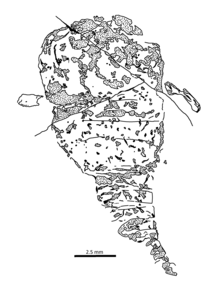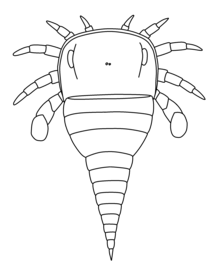Forfarella
Forfarella is a genus of chasmataspidid, a group of extinct aquatic arthropods.
| Forfarella | |
|---|---|
 | |
| Camera lucida drawing of the holotype of F. mitchelli | |
| Scientific classification | |
| Kingdom: | Animalia |
| Phylum: | Arthropoda |
| Subphylum: | Chelicerata |
| Clade: | Dekatriata |
| Order: | †Chasmataspidida |
| Family: | †Diploaspididae |
| Genus: | †Forfarella Dunlop, Anderson & Braddy, 1999 |
| Type species | |
| †Forfarella mitchelli Dunlop, Anderson & Braddy, 1999 | |
Description

Like the other chasmataspidids, F. mitchelli was a small arthropod, with the size of its only known specimen estimated at only 1.7 centimetres (0.67 inches).[1]
Its carapace (dorsal plate of the head) was wide and rectangular. It was broader than long; 0.76 cm (0.30 in) wide and 0.52 cm (0.20 in) long. Although the details on its surface are little preserved, a tubercle is distinguished in the left anterior corner of the carapace if it is placed under plane polarized light. This tubercle most likely represents a lateral eye. The appendages (limbs) are only known from two fragments on both left and right sides, probably belonging to the sixth (and last) pair of them. The left one had a length of 0.16 cm (0.063 in) and a width of 0.07 cm (0.028 in), while the right one was 0.27 cm (0.11 in) long and 0.06 cm (0.024 in) wide.[1]
The opisthosoma (abdomen), made up of 13 segments,[2] had a total length of 1.18 cm (0.46 in). The preabdomen (segments 1 to 4) was subtrapezoidal (nearly as a trapezoid) and narrowed posteriorly. Vague impressions distinguish the second, third and fourth tergites (dorsal half of the segments), but not the first one. The postabdomen (segments 5 to 13) also tapered posteriorly and was longer, with its 9 tergites distinguishable in the fossil and with a length of approximately 0.08 cm (0.031 in) each. The telson ("tail") is unknown,[1] but it was probably short as in other contemporary chasmataspidids.[3] The specimen had two cracks all over the prosoma (the head) and preabdomen, as well as dark patches probably corresponding to the ornamentation.[1]
History of resarch
Forfarella is known from one single specimen, BMNH In 60023. It was found in the Old Red Sandstone near Arbroath, Scotland, in the United Kingdom. According to the label associated with the fossil, it was purchased in 1893 from the collection of a person surnamed Mitchell, who, along with other colleagues, was one of the fossil collectors in the area who did not usually specify the exact type locality of his material. This rendered its tracking problematic, but comparisons with other fossils from Mitchell's collection that had more details about its origins and the fossil's label suggest the Kelly Den south of Arbirlot, although this cannot be confirmed. Following the purchase, the fossil of Forfarella was not instantly registered in the Natural History Museum of London like other fossils of Mitchell's collection.[4]
In 1962, the British paleontologist Charles D. Waterston borrowed the still unregistered In 60023, as well as four other fossils of juvenile eurypterids, to describe them. He noted the chasmataspidid nature of In 60023, and coined the name Forfarella mitchelli. However, Waterston would never publish his description, returning the fossil to the museum three years later, where it would be labeled with the name given by the paleontologist. Thus, Forfarella mitchelli remained as a nomen manuscriptum (a taxonomic name that appears in an informally published document). But despite the turbulent history of the fossil, the paleontologists Jason A. Dunlop, Lyall I. Anderson and Simon J. Braddy formally proposed and described Forfarella mitchelli for the first time in 1999 as a new genus of chasmataspidid. The name suggested by Waterston was kept to avoid future confusion. Anderson also studied a troublesome specimen allegedly at the National Museum of Scotland (later discovering that it was not there), which could represent another specimen of Forfarella. However, upon examination, it was discovered that it was not a chasmataspidid, but a poorly preserved undetermined arthropod fragment.[4]
References
- Dunlop, Anderson & Braddy 1999, p. 164.
- Dunlop, Anderson & Braddy 1999, p. 162.
- Dunlop, Anderson & Braddy 1999, p. 163.
- Dunlop, Anderson & Braddy 1999, p. 161–162.
Cited bibliography
- Dunlop, Jason A.; Anderson, Lyall I.; Braddy, Simon J. (1999). "A new chasmataspid (Chelicerata: Chasmataspida) from the Lower Devonian of the Midland Valley of Scotland". Transactions of the Royal Society of Edinburgh: Earth Sciences. 89 (3): 161–165. doi:10.1017/S0263593300007100.